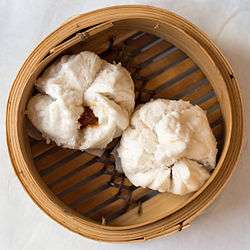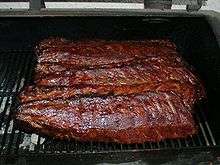Cha siu bao
Cha siu bao (simplified Chinese: 叉烧包; traditional Chinese: 叉燒包; pinyin: chāshāo bāo; Cantonese Yale: chāsīu bāau) is a Cantonese barbecue-pork-filled bun (baozi).[1] The buns are filled with barbecue-flavored cha siu pork.[1] They are served as a type of dim sum during yum cha and are sometimes sold in Chinese bakeries.[1][2] Cha siu refers to the pork filling; the word bao means "bun".
 | |
| Alternative names | Char siu bao, chashaobao, manapua, or keke pua'a |
|---|---|
| Type | Dim sum |
| Place of origin | Southern [china] |
| Serving temperature | Hot |
| Main ingredients | Pork |
| Variations | Baked or steamed |
| 501.2 kcal (2098 kJ) | |
| Cha siu bao | |||||||||||||||||||||||
|---|---|---|---|---|---|---|---|---|---|---|---|---|---|---|---|---|---|---|---|---|---|---|---|
| Simplified Chinese | 叉烧包 | ||||||||||||||||||||||
| Traditional Chinese | 叉燒包 | ||||||||||||||||||||||
| Jyutping | caa1siu1 baau1 | ||||||||||||||||||||||
| Hanyu Pinyin | chāshāo bāo | ||||||||||||||||||||||
| Literal meaning | "barbecued pork bun" | ||||||||||||||||||||||
| |||||||||||||||||||||||

Varieties
There are two major kinds of cha siu bao, the traditional steamed version is called 蒸叉燒包 (pinyin: zhēng chāshāo bāo; Cantonese Yale: jīng chāsīu bāau) or simply 叉燒包 (chāshāo bāo; chāsīu bāau), while the baked variety is usually called 叉燒餐包 (chāshāo cān bāo; chāsīu chāan bāau). Steamed cha siu bao has a white exterior, while the baked variety is browned and glazed.
Cantonese cuisine
Although visually similar to other types of steamed baozi, the dough of steamed cha siu bao is unique since it makes use of both yeast and baking powder as leavening.[3][4] This unique mix of leavening gives the dough of cha siu bao the texture of a slightly dense, but fine soft bread.
Encased in the center of the bun is tender, sweet, slow-roasted pork tenderloin. This cha siu is diced, and then mixed into a syrupy mixture of oyster sauce, hoisin sauce, roasted sesame seed oil, rice vinegar, shaoxing wine or dry sherry, soy sauce, sugar, and cornstarch.[5]
Philippine cuisine
Siopao (simplified Chinese: 烧包; traditional Chinese: 燒包; Pe̍h-ōe-jī: sio-pau; Tagalog pronunciation: [ˈʃupaʊ]), literally meaning "hot bun", is the Philippine indigenized version of the Cantonese steamed bun called cha siu bao.[6]
Polynesian cuisine
In Hawaii, the item is called manapua. Its name is a shortening of the Hawaiian mea ʻono puaʻa, meaning "delicious pork thing". On the US mainland, the Chinese term is commonly used. The Chinese immigrants brought this dim sum item with them when they were brought over as plantation workers. In American Samoa and its surrounding islands, the item is referred to as keke pua'a, literally meaning "pig cake".
This food usually consists of a white bun with a dark pink-colored diced pork filling. The Hawaiian version of the cha siu bao tends to be larger than its Chinese cousin and can be either steamed or baked. In Hawaii starting in the plantation era, manapua sellers were and still are a common occurrence and have even become iconic symbols of Hawaii. The red pork filling's dark pink color comes from marinating the pork with a very small amount of saltpeter prior to slow roasting. The bun is occasionally baked, but more frequently is steamed when it is made. Manapua has come to mean any meat-filled or bean-paste-filled bun made with the same dough as described above, including locally-created versions with hot dogs, curry chicken, kalua pig, and even ube (purple yam), which is a popular vegetarian version of the manapua. In Hawaii, freshly prepared or prepackaged frozen manapua may be found in dedicated bakeries, restaurants, and chain convenience stores.
In addition to existing in Hawaii, bao buns are also commonly found in Tahiti, French Polynesia. In Tahiti they are called chao pao, and were brought to the islands during the Chinese migration wave dating back to the mid 1800s. Despite its long Tahitian history, the chao pao retains all its authentic characteristics. The chao pao is a local favorite and is commonly sold all over the island in Chinese mom-and-pop stores as a breakfast item.
See also
- Bánh bao (Vietnam)
- Dim sum
- Goubuli (aka "Go Believe")
- Jjinppang/Hoppang (South Korea)
- List of buns
- List of pork dishes
- List of snack foods
- List of steamed foods
- List of stuffed dishes
- Nikuman (Japan)
- Siopao (Philippines)
References
- Hsiung, Deh-Ta. Simonds, Nina. Lowe, Jason. [2005]. The Food of China: A Journey for Food Lovers. Bay Books. ISBN 978-0-681-02584-4. p. 24.
- Christopher DeWolf; Izzy Ozawa; Tiffany Lam; Virginia Lau; Zoe Li (13 July 2010). "40 Hong Kong foods we can't live without". CNN Go. Archived from the original on 2012-11-05. Retrieved 14 August 2012.
- rec.food.recipes Luckytrim, Chinese Pork Buns (Char Siu Bao) Recipe
- Michelle Che, Chinese Pork Buns (Cha Siu Bao)
- Geni Raitisoja (June 25, 2008). "Chinese recipes: char siu (barbecued pork)". All About China. Radio86. Archived from the original on 2012-03-27.
- Frances Lorraine Haw-Ang (August 25, 2010). "Top 10 Siopao in Manila". www.spot.ph. Retrieved 21 December 2010.
